Catalog Ads for brands and DTC companies
April 9, 2025
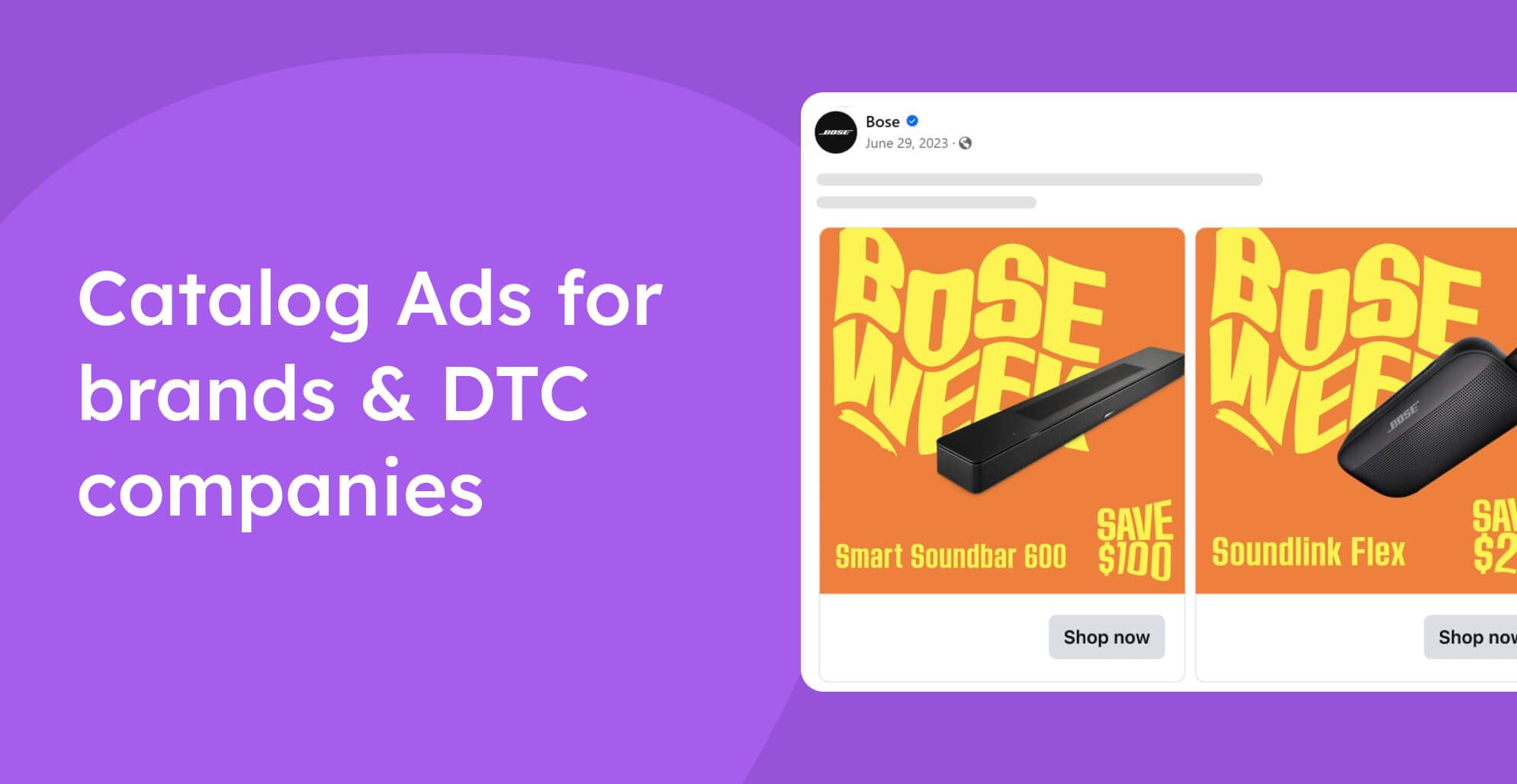
If you’re a brand that sells to consumers on Facebook or Instagram, you probably already know that catalog ads are one of THE best ways to get as many of your products as possible in front of potential customers.
When running catalog ads on Meta platforms, users see a bunch of your products all in a single ad, just as if they were browsing through a physical copy of a store’s product catalog.
Bookmark this page by pressing ctrl + D / cmd + D, or by clicking the star icon in your URL bar ⭐️.
Truly, catalog ads are a great shopping experience for the consumers.
And they’re effective at getting people to shop and buy from you, which is good for your bottom line too!
But did you know that there are a ton of different tricks you can use to supercharge your catalog ads?
Like using Confect to generate catalog ad overlays that instantly show your viewers vital information about your products to help them convert into paying customers!
But there’s one problem:
With so many different overlays and design options you use for your catalog ads, it’s hard to know which to choose and which will have the biggest impact on your ad performance.
So in the following guide, we’re exploring the many different ways that brands just like yours can use price, brand assets, product details, and so much more to gain an edge over the competition.
Here you have the insights in a quick cheat sheet - click to get more details:
The most used product fields in Catalog Ads designs:
The moderately used product fields in Catalog Ads designs:
The rarely used product fields in Catalog Ads designs:
Showing Prices in your Catalog Ads
Not surprisingly, one of the biggest jumps in ad performance can come from including pricing information in your catalog ads.
The reason that including prices helps so much is because it instantly answers one of the biggest questions potential customers have, which is often: “How much will I need to spend to buy that?”
Even though prices are effective for brands themselves, multi-brand retailers see the biggest improvement in performance when showing prices in their Catalog Ads.
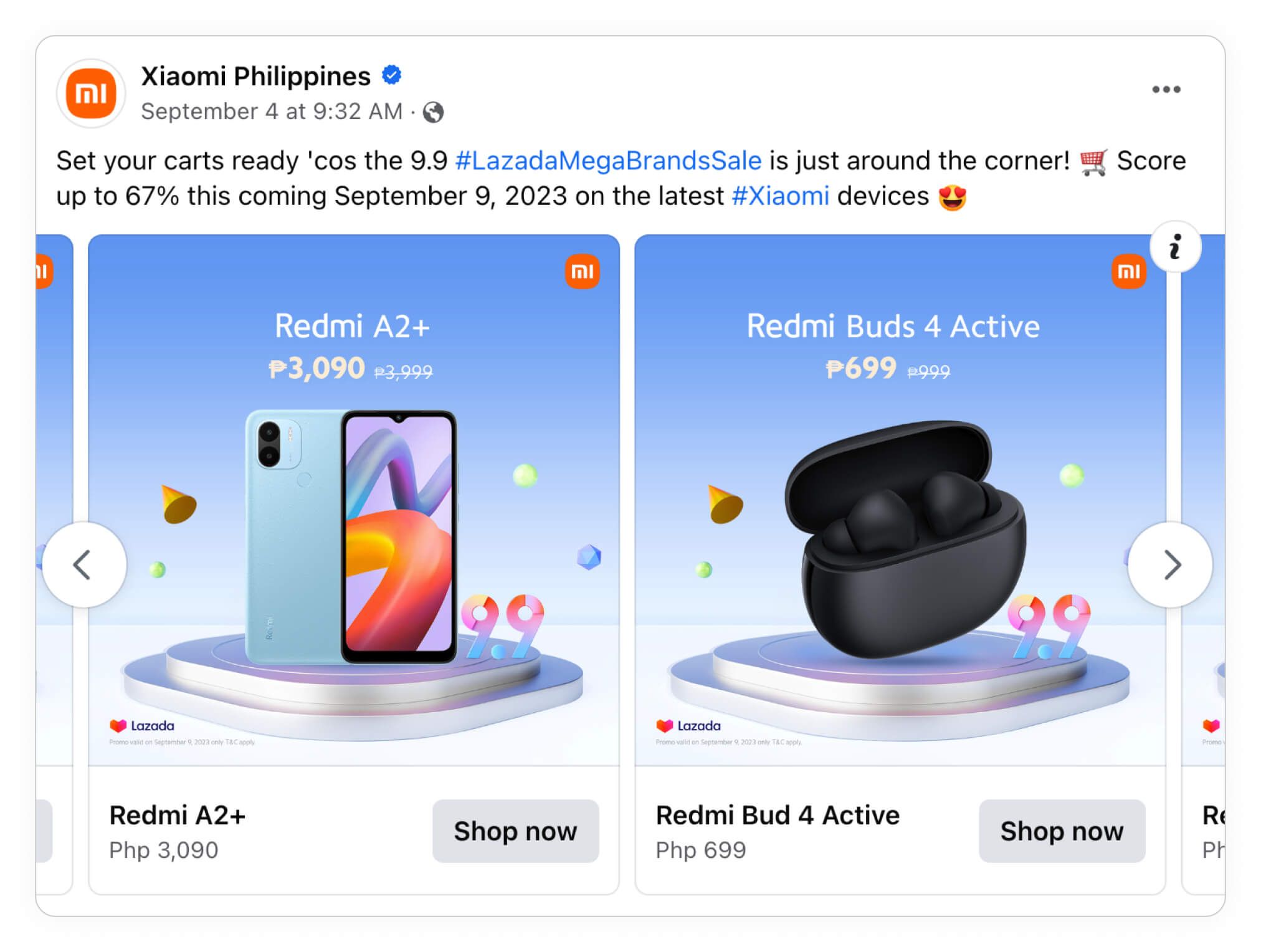
So by providing this information directly on the ad image overlay, you instantly answer this question and remove one of the biggest hesitancies customers might have.
If they see the price and think it’s too high, they move on.
No harm, no foul.
But if they see the price and feel it’s within their budget, there’s a good chance they’ll click on the ad to learn more about the product and how they can get their hands on it.
But just how much can including price improve your ad performance?
- Brands and DTC companies see a +25% improvement in Return on Ad Spend when showing prices
- Multi-brand stores see a +56% improvement in Return on Ad Spend when showing prices
You can learn more about showing prices in your Catalog Ads right here.
Here's how showing prices on average influence Catalog Ads:
Return On Ad Spend
+25%
Cost Per Purchase
-13%
Click Through Rate
-17%
Cost Per Click
-9%
Conversion Rate
-3%
Usage
49%
These numbers show how Catalog Ads showing prices perform on average compared to Catalog Ads not showing prices.
Remember that these are average numbers. For some brands, prices perform better, and for other brands, prices perform worse.
Showing your Logo in Catalog Ads
A logo can say a lot about your brand, its products, and how your viewers see you and think about what you’re selling.
But that doesn’t mean you’ll see all that big of an improvement when showing your logo on your catalog ads.
In fact, for brands showing their logo, we’ve only clocked an average +5% boost in ROAS.
And while there’s nothing wrong with a 5% increase on your return, it’s not as huge of an improvement as you might get with showing other types of information in your overlays.
That said, there are still some benefits that can come from showing your logo, such as:
Brands that include their logo see an average -26% reduction in Cost Per Click
Including your logo can boost Click-Through Rate by +9%
Catalog ads with a logo see a -18% reduction in Cost Per Purchase
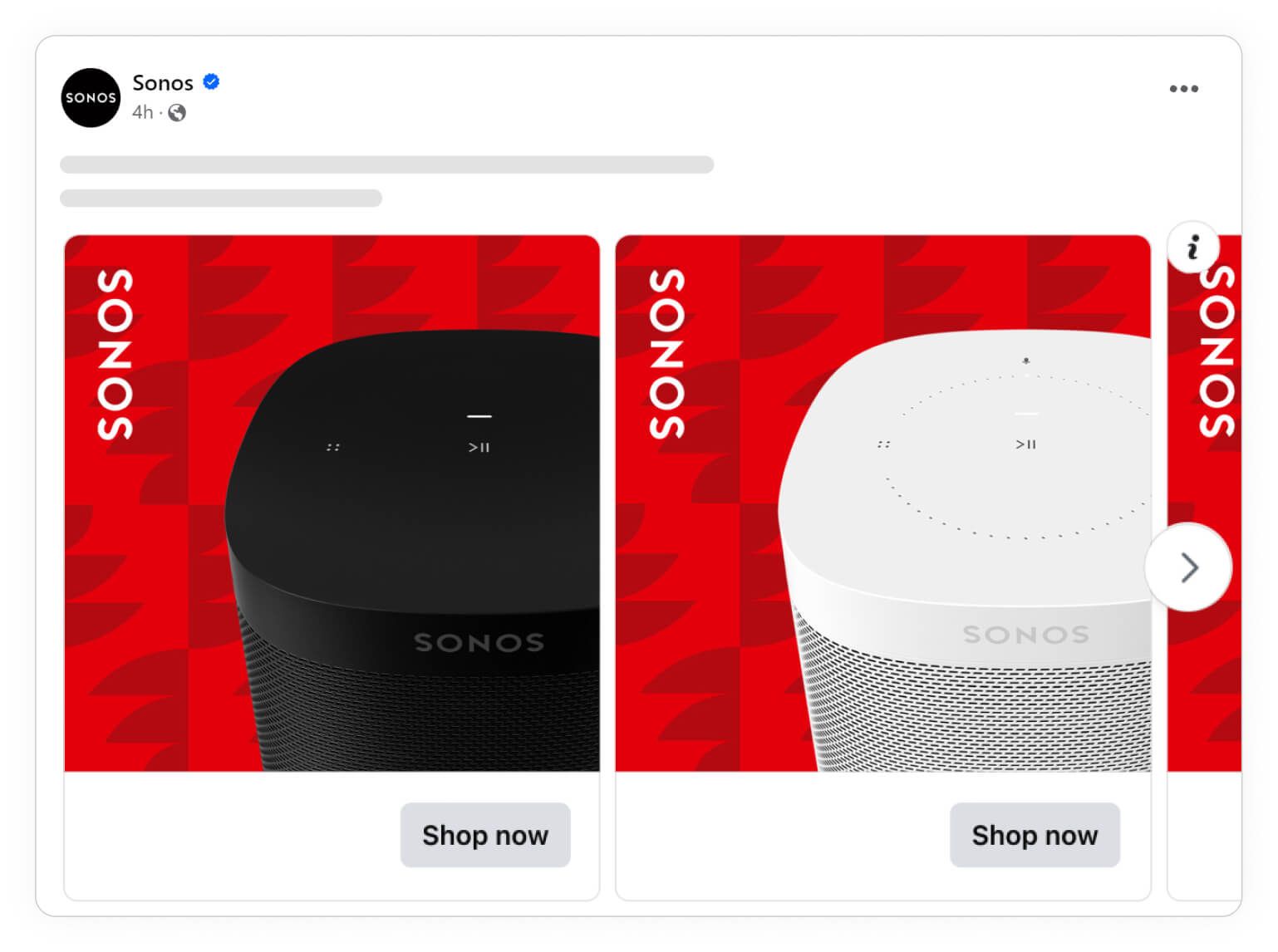
Here's how showing your logo on average influence Catalog Ads:
Return On Ad Spend
+5%
Cost Per Purchase
-18%
Click Through Rate
+9%
Cost Per Click
-26%
Conversion Rate
-30%
Usage
54%
These numbers show how Catalog Ads showing the logo of the advertiser perform on average compared to Catalog Ads not showing the logo.
Remember that these are average numbers. For some brands, their logo perform better, and for other brands, their logo perform worse.
Showing On-sale designs in your Catalog Ads
For some brands, sales are a dime-a-dozen and are often a central facet of how they interact with and entice people into buying from them.
But for DTC brands like yours, you might not run sales as often.
Either way, you already know that sales are a great way to entice people into buying your products.
But did you know that catalog ads with on-sale designs can provide as much as a +47% Return on Ad Spend (ROAS)?
And not only that… Including on-sale designs in your catalog ads can also reduce your cost per purchase, click-through rate, and your average cost per click!
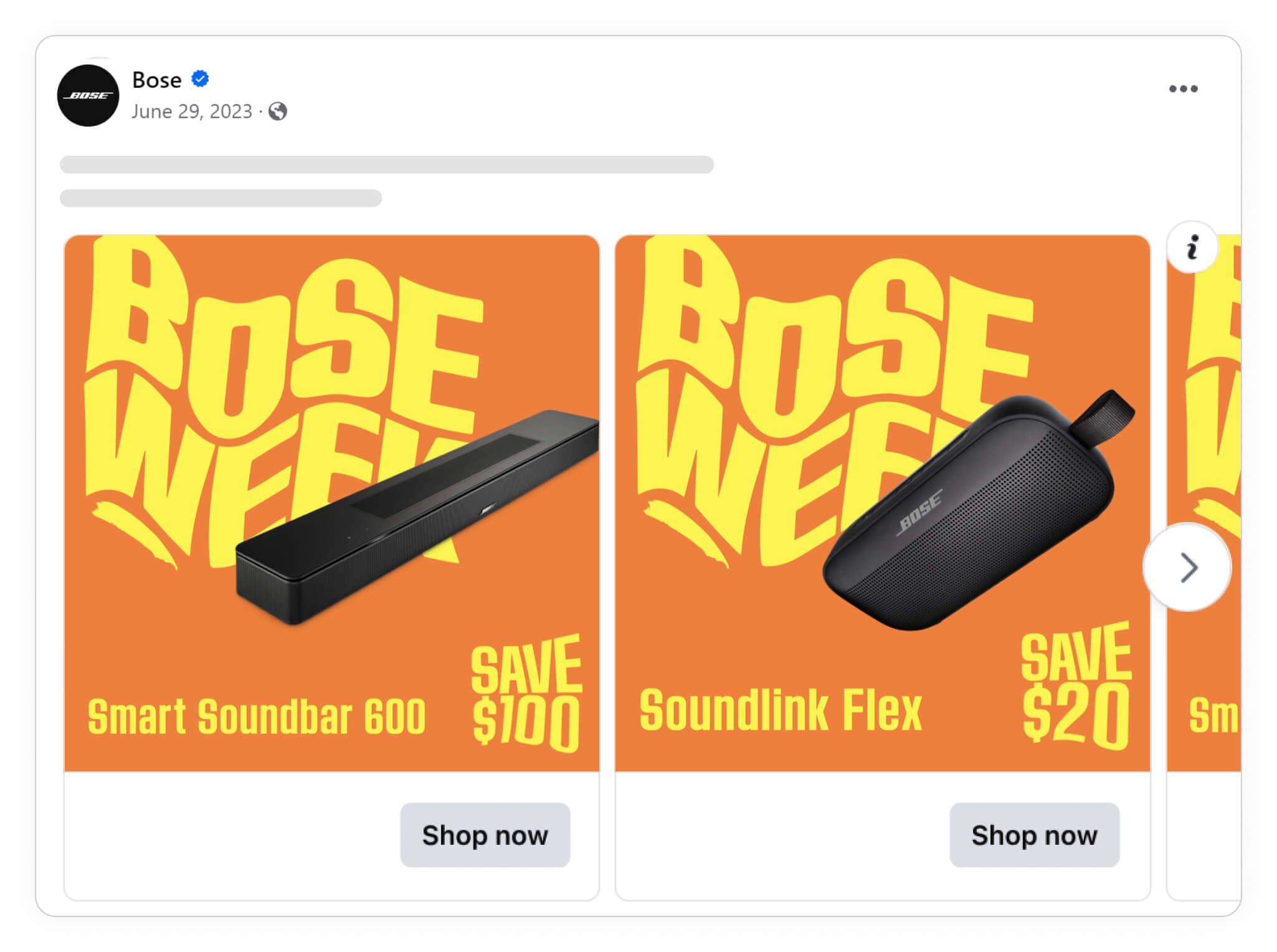
On the downside of this, you might also experience a -34% reduction in your conversion rate.
So essentially, on-sale designs do help get people interested and clicking on your ads, but that doesn’t mean they're going to pull the trigger and make a purchase.
Here's how showing on-sale designs on average influence Catalog Ads:
Return On Ad Spend
+47%
Cost Per Purchase
-27%
Click Through Rate
+20%
Cost Per Click
-37%
Conversion Rate
-34%
Usage
38%
These numbers show how Catalog Ads showing on-sale designs perform on average compared to Catalog Ads not showing on-sale designs.
Remember that these are average numbers. For some brands, on-sale designs perform better, and for other brands, on-sale designs perform worse.
Showing Product Names in your Catalog Ads
Showing names and titles of products works best for multi-brand stores, which often sell many more different products compared to the brands themselves.
The thing is that for certain products, all the viewer needs to see is an image and they’ll instantly know whether or not it’s something they’re interested in.
For example, when it comes to clothing and accessories, other than seeing the image of a watch, a t-shirt, or a hat, knowing the specific name of the product won’t really matter.
After all, the product name of a hat won’t provide the viewer with any additional insight to help them decide if the hat is for them.
But for other type of products, like that laptop you’ve been eyeing for a while, the product name can really help you know whether or not it’s something you want to spend your hard-earned money on.
Just remember, though, this may or may not work for your brand depending on the types of products you sell.
So just be sure to reflect on whether or not the name of the product provides any real value or information to the viewer.
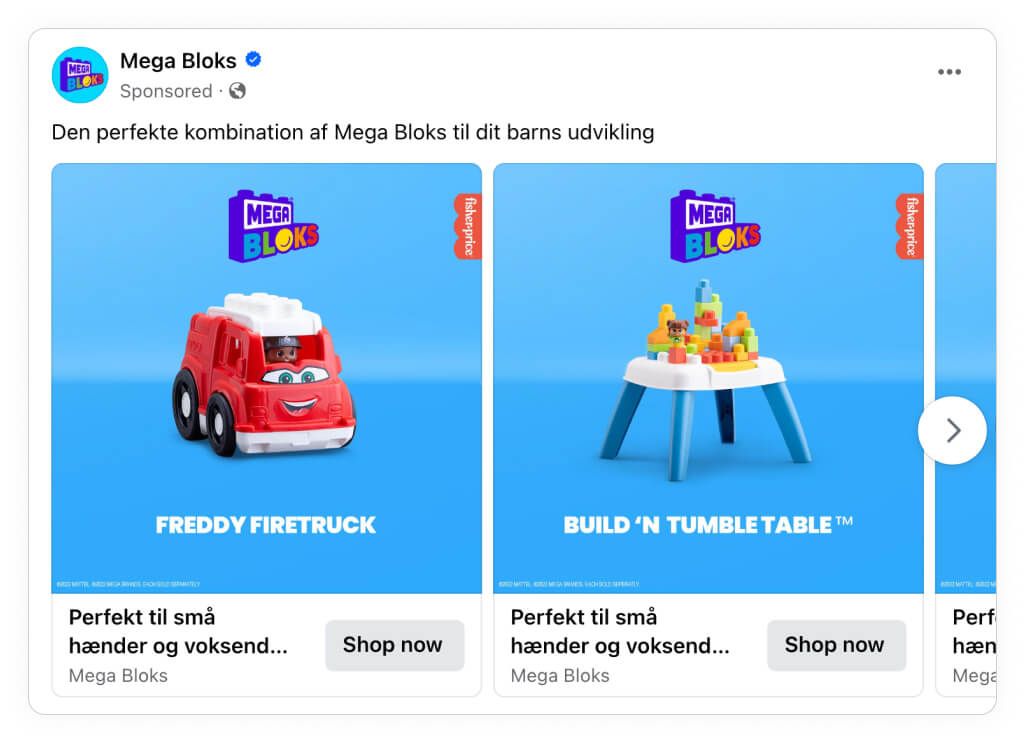
Regardless, showing product names does benefit ad performance:
- Brands and DTC companies see a +11% improvement in Return on Ad Spend when showing product names
- Multi-brand stores see a +31% improvement in Return on Ad Spend when showing product names
You can learn more about showing product names in your Catalog Ads right here.
Here's how showing product names on average influence Catalog Ads:
Return On Ad Spend
+11%
Cost Per Purchase
-29%
Click Through Rate
+10%
Cost Per Click
-27%
Conversion Rate
-17%
Usage
44%
These numbers show how Catalog Ads showing product names perform on average compared to Catalog Ads not showing product names.
Remember that these are average numbers. For some brands, product names perform better, and for other brands, product names perform worse.
Showing Original prices in your Catalog Ads
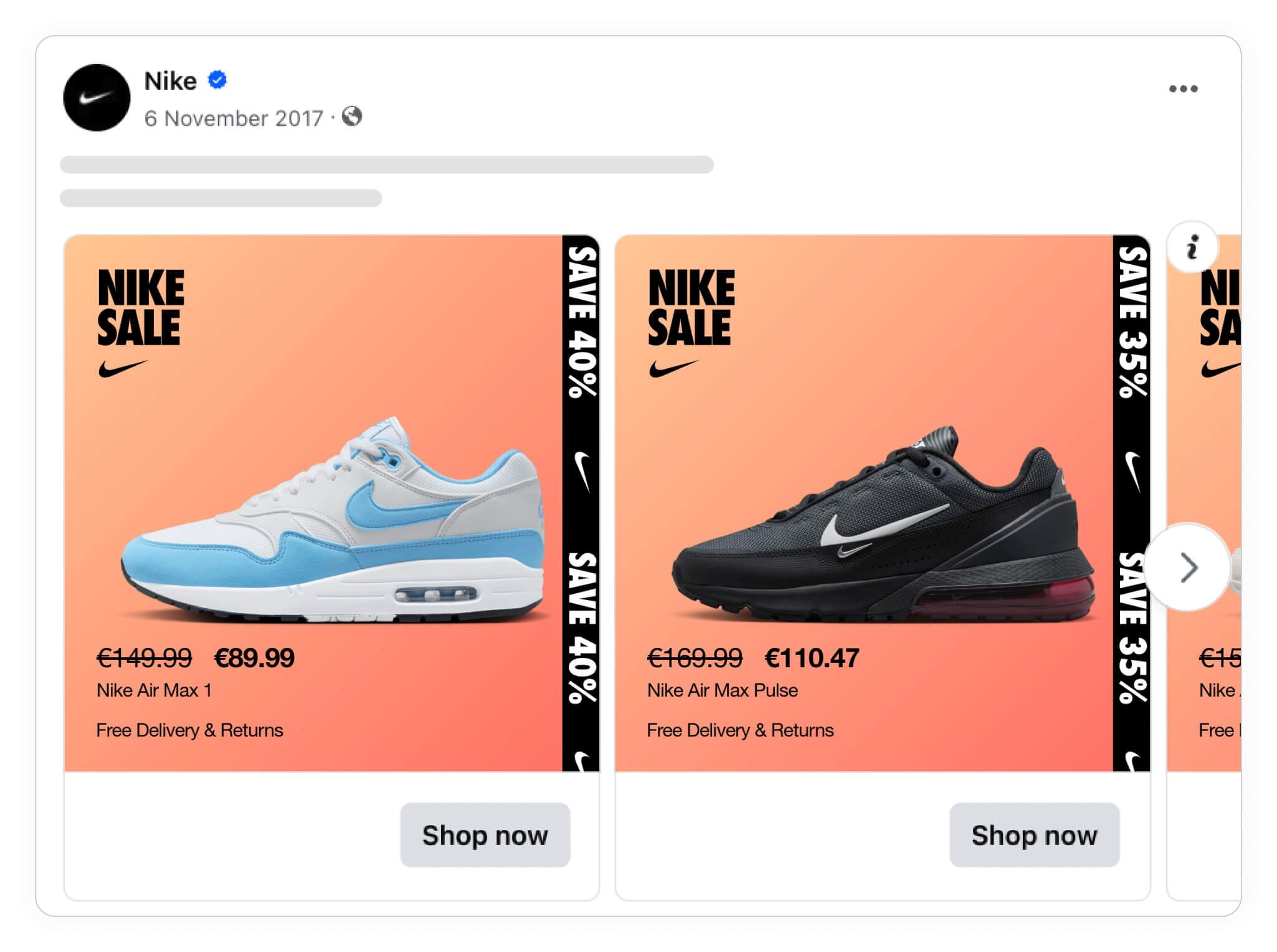
Here's how showing original prices on average influence Catalog Ads:
Return On Ad Spend
+47%
Cost Per Purchase
-22%
Click Through Rate
+6%
Cost Per Click
-36%
Conversion Rate
-40%
Usage
25%
These numbers show how Catalog Ads showing original prices perform on average compared to Catalog Ads not showing original prices.
Remember that these are average numbers. For some brands, original prices perform better, and for other brands, original prices perform worse.
Showing additional images in your Catalog Ads
Additional images can also provide a boost to your catalog ad performance.
Basically, showing additional images allows your brand to show off its products in all sorts of different, unique eye-catching ways.
For instance, you might show off a single item in a bunch of different ways, switching up angles, background colors, models, etc.
Alternatively, you could also show the same product in several different sizes, colors, or variations.

For example, check out the ad above. Moonlight Mansion decided to show not only an image of the t-shirt they’re selling…
They also show images of the t-shirt being worn in different ways, from the front and back, on a model in different poses, AND they show it in two different color variations!
But just how much of an effect do additional images have on catalog ads?
Here's how showing additional images on average influence Catalog Ads:
Return On Ad Spend
+6%
Cost Per Purchase
+7%
Click Through Rate
+12%
Cost Per Click
-12%
Conversion Rate
-18%
Usage
31%
These numbers show how Catalog Ads showing additional images perform on average compared to Catalog Ads not showing additional images.
Remember that these are average numbers. For some brands, additional images perform better, and for other brands, additional images perform worse.
Showing Savings and Discounts in your Catalog Ads
Savings and discounts are almost always good ways to make people buy, but it's interesting how they are a bit more effective for the brands themselves than for multi-brand stores.
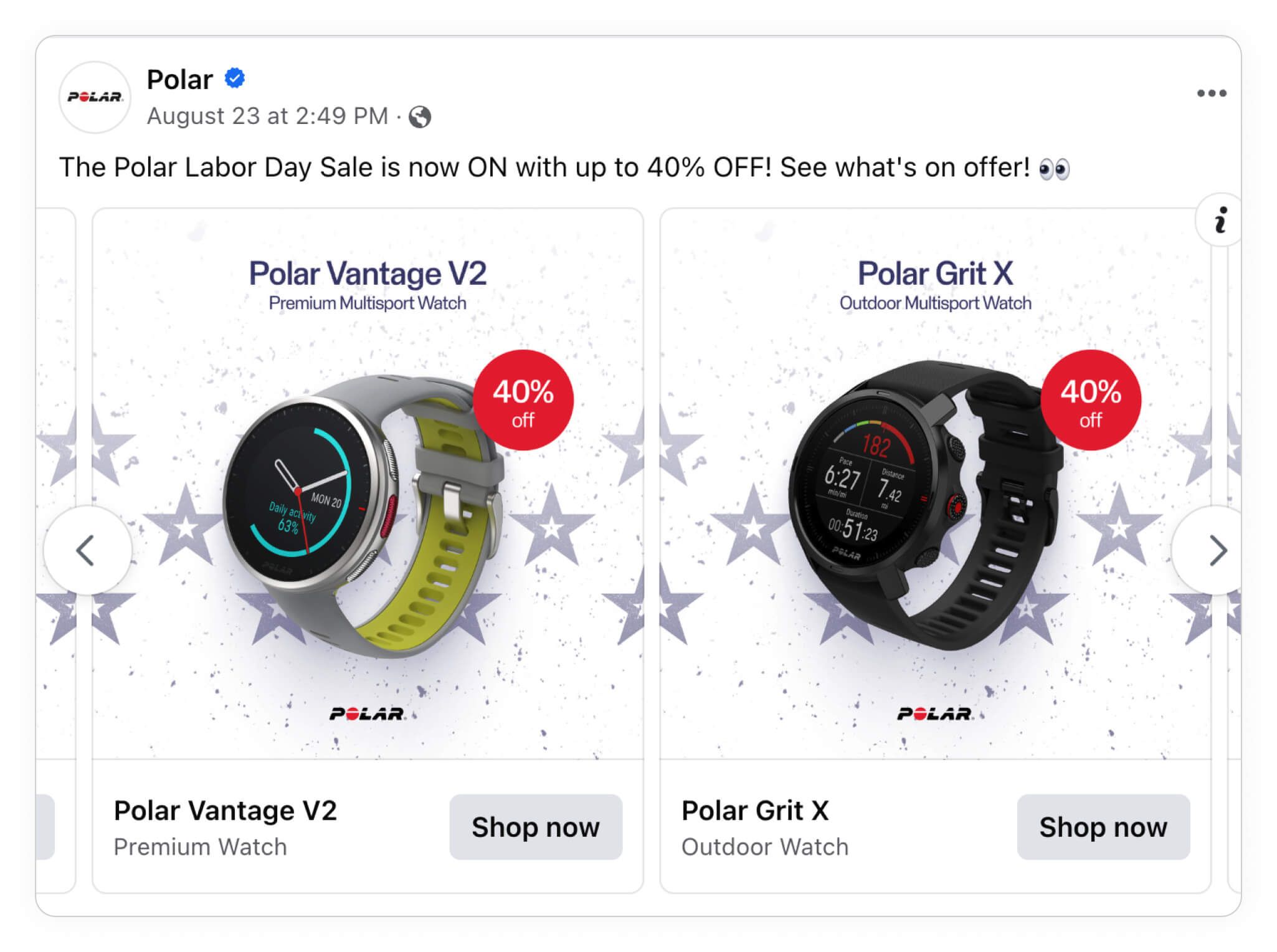
- Brands and DTC companies see a +73% improvement in Return on Ad Spend when showing savings and discounts
- Multi-brand stores see a +54% improvement in Return on Ad Spend when showing savings and discounts
As you can see, including savings and discount information can make a huge difference in how your ads perform.
Simply slapping a “40% off” sticker on your catalog ads instantly lets the viewer know they’re looking at a good deal, which can result in as much as a +73% boost to your ROAS.
Discounts like this immediately anchor the viewer’s price perception and tilts it in favor of your brand’s next sale.
In other words, when someone sees that a product is 40% off, they immediately think about how they’re getting that $100 product for just $60…
And savings like that, especially in today’s world, are great for drawing customers in and converting them into paying customers.
You can learn more about showing savings and discounts in your Catalog Ads here.
Here's how showing savings on average influence Catalog Ads:
Return On Ad Spend
+73%
Cost Per Purchase
-14%
Click Through Rate
-2%
Cost Per Click
-18%
Conversion Rate
-10%
Usage
17%
These numbers show how Catalog Ads showing savings perform on average compared to Catalog Ads not showing savings.
Remember that these are average numbers. For some brands, savings perform better, and for other brands, savings perform worse.
Showing Dates in your Catalog Ads
Dates are especially effective for multi-brand stores.
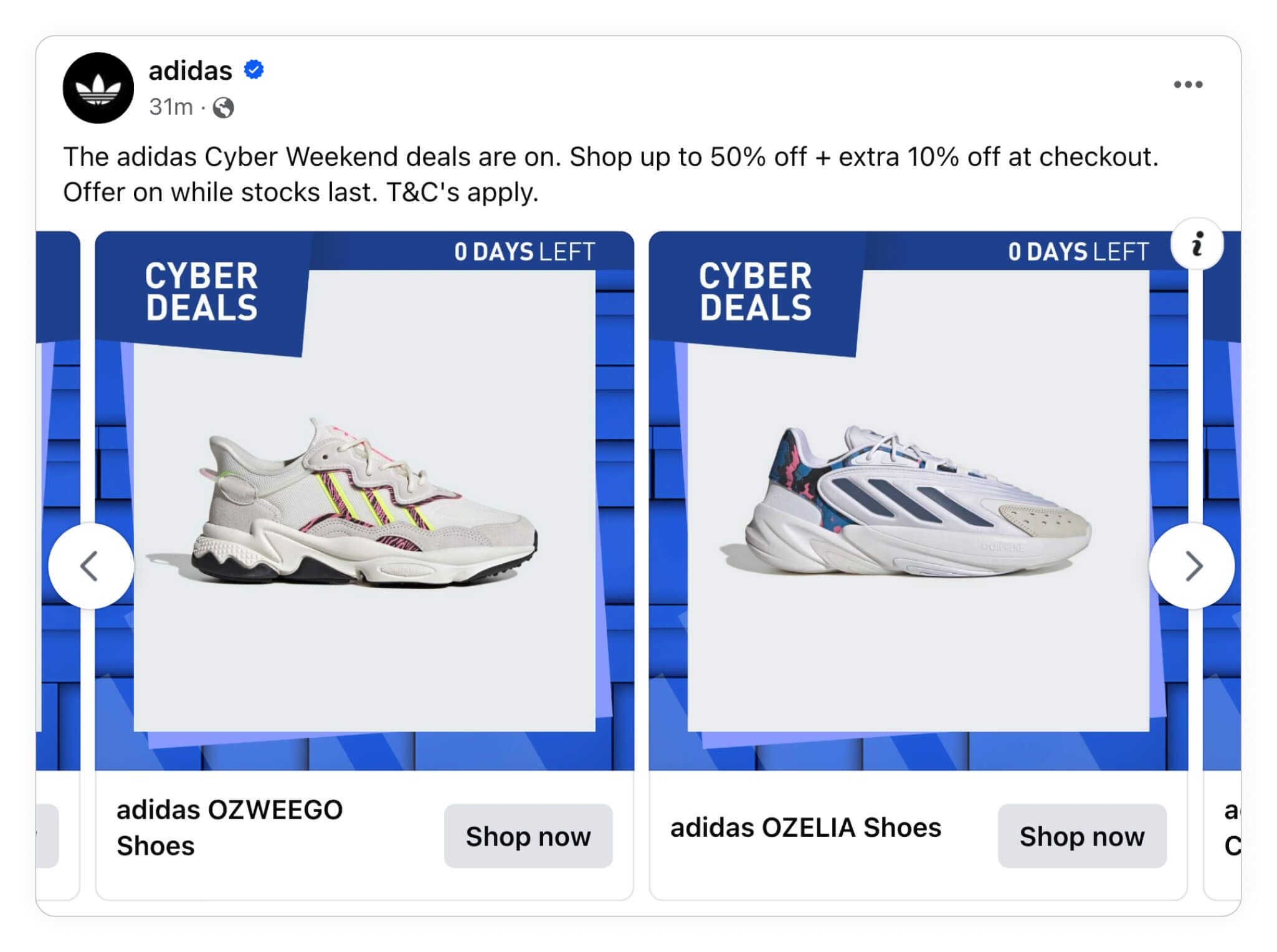
- Brands and DTC companies, on average, don't see improvements in Return on Ad Spend when showing dates
- Multi-brand stores see a +49% improvement in Return on Ad Spend when showing dates
It’s a bit tricky to pinpoint exactly why multi-brand stores see better performance when dates are included, but DTC brands don’t really see any improvement.
Either way, including dates in your catalog ads can evoke a sense of urgency in the viewer.
Essentially, when someone sees a price discount that’s only for a limited time, it makes them want to take advantage of that deal now, rather than waiting and possibly missing out on a good deal.
Like many things in life, the fear of missing out (FOMO), can be a powerful decision-making factor.
So the more a viewer feels like they might miss out on a great opportunity, the more likely they will be to act impulsively and buy your products right then and there!
But, while you might boost your Conversion rate by +15%, you won’t likely see much of an improvement in your ROAS or your Click-Through Rate.
Here's how showing dates on average influence Catalog Ads:
Return On Ad Spend
-0%
Cost Per Purchase
+0%
Click Through Rate
-11%
Cost Per Click
+24%
Conversion Rate
+15%
Usage
19%
These numbers show how Catalog Ads showing dates perform on average compared to Catalog Ads not showing dates.
Remember that these are average numbers. For some brands, dates perform better, and for other brands, dates perform worse.
Highlighting News in your Catalog Ads
Highlighting new products or features in your catalog is yet another great way to supercharge your ads.
In fact, brands that highlight news in their catalog ads can reduce their average cost per click by as much as -33%.
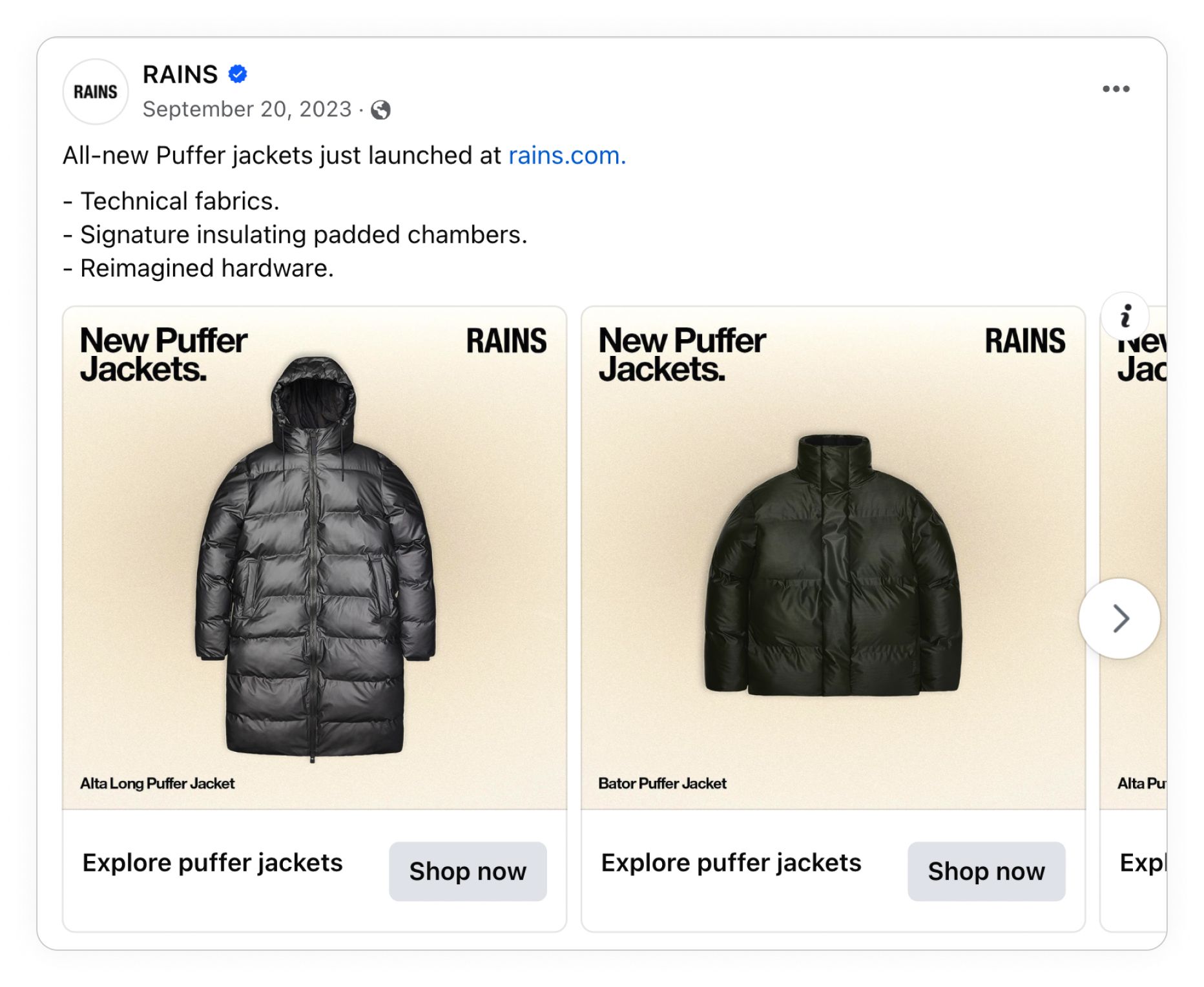
Essentially, this also boils down to FOMO and enticing people into feeling like they could miss out on something great.
You see, inside all of us, there’s a person that truly wants to have the newest accessories, the hottest fashion, and the latest tech gadgets.
Which is why it’s always a good idea for brands like yours to highlight the newest, hottest products they have in their stores!
After all, when brands highlight news, they see a small boost to their ROAS (+9%) and Click-through rate (+9%), and as much as a -33% reduction in their average Cost Per Click.
Here's how highlighting news on average influence Catalog Ads:
Return On Ad Spend
+9%
Cost Per Purchase
-16%
Click Through Rate
+9%
Cost Per Click
-33%
Conversion Rate
-28%
Usage
21%
These numbers show how Catalog Ads highlighting news perform on average compared to Catalog Ads not highlighting news.
Remember that these are average numbers. For some brands, highlighting news perform better, and for other brands, highlighting news perform worse.
Showing Shipping info in your Catalog Ads
It is rare to see shipping information improving the performance of Catalog Ads, but when looking at shop types, we actually see a big difference:
Customers don’t care about shipping information from brands themselves, whereas multi-brand stores might benefit from telling customers in the ads directly.
Brands and DTC companies should talk more about themselves and their products, not about shipping information, which is likely the same for other brands.
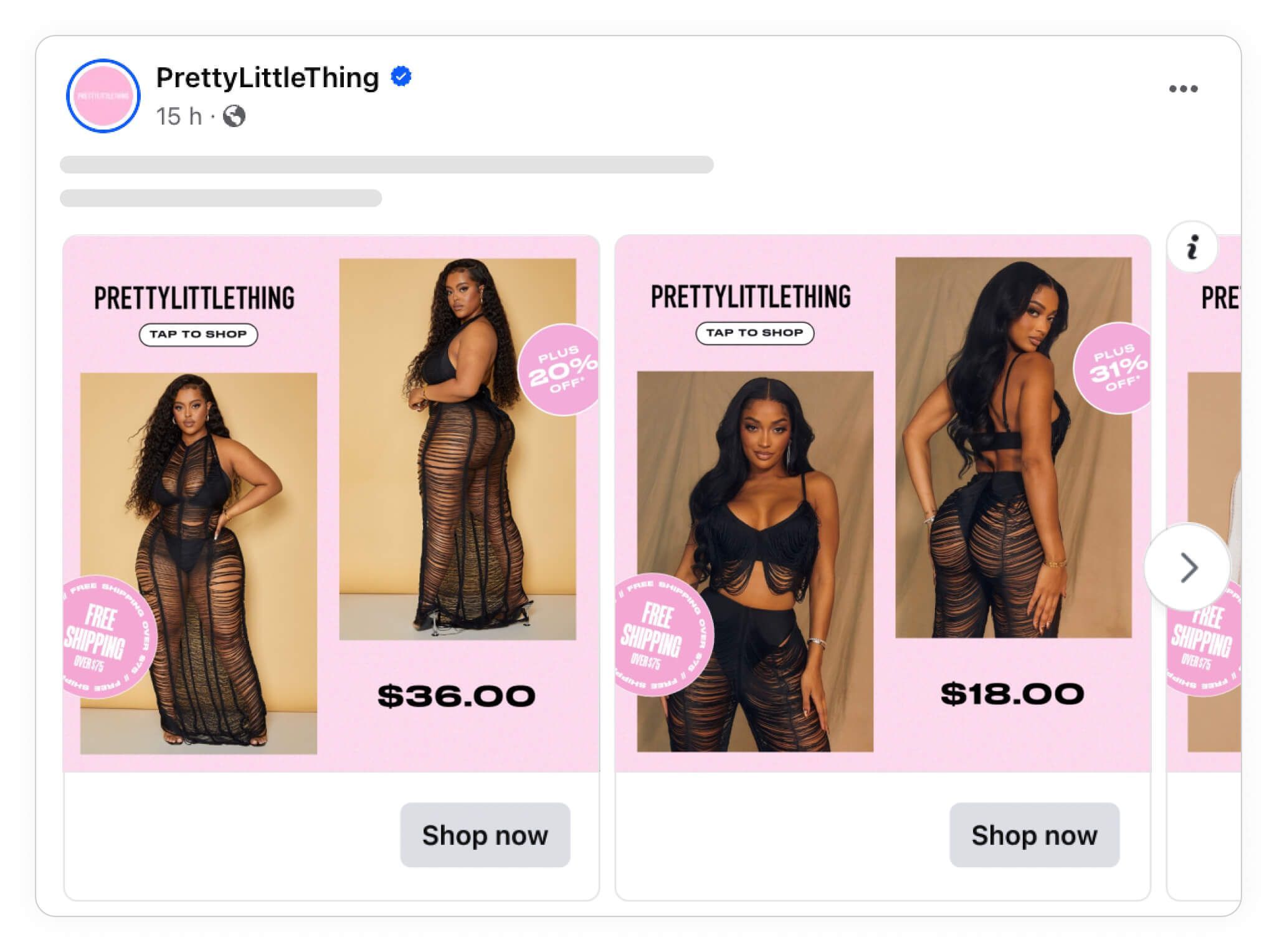
- Brands and DTC companies see a -38% decrease in Return on Ad Spend when showing shipping information
- Multi-brand stores see a +11% improvement in Return on Ad Spend when showing savings and discounts
Why is there such a big difference between DTC brands and multi-brand sellers?
Well, we can’t say for certain.
But we can tell you that shipping information doesn’t have the best track record when it comes to showing it on your catalog ads.
As you can see below, shipping information can have some pretty nasty negative effects on your ad performance, including a significant reduction in your Return On Ad Spend, a lower Click-Through Rate, and a lower Conversion Rate.
Here's how showing shipping info on average influence Catalog Ads:
Return On Ad Spend
-38%
Cost Per Purchase
-26%
Click Through Rate
-2%
Cost Per Click
-30%
Conversion Rate
-26%
Usage
16%
These numbers show how Catalog Ads showing shipping information perform on average compared to Catalog Ads not showing shipping information.
Remember that these are average numbers. For some brands, shipping info perform better, and for other brands, shipping info perform worse.
Using Product Assets in your Catalog Ads
Product assets are dynamic elements that brands can add to their product images as visual overlays.
So essentially, you can display different information based on the existing attributes of your products.
The product asset information then changes dynamically depending on which product is currently being viewed.
For example, if you ran a DTC brand that sold computers, you might display product assets such as the product’s RAM or HD size, monitor size, etc.
Then, as the viewer swipes through different products, the overlay would change to reflect the current item’s specs.
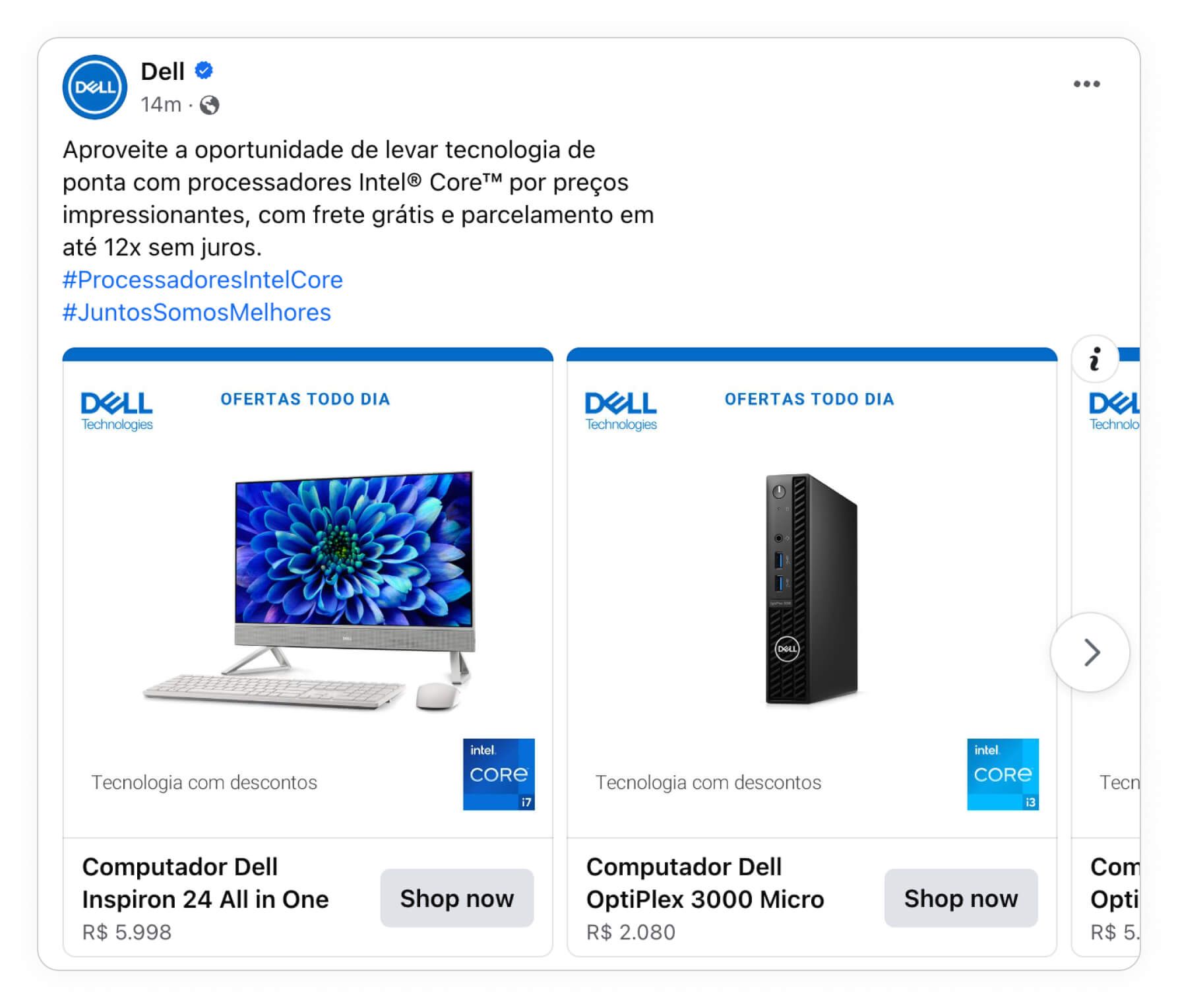
That said, Product Assets are a bit hit or miss when it comes to ad performance.
Showing Product Assets on your catalog ads can increase your conversion rate by as much as 33%
But on the downside of this, your average ROAS and click-through rate might suffer, and your average cost per purchase might jump up.
So don’t be scared to try using Product Assets in your catalog ads to see if they work for your brand and its products.
But do make sure to A/B test and find out if they’re having a positive or negative impact on your ad performance overall.
Here's how showing product assets on average influence Catalog Ads:
Return On Ad Spend
-8%
Cost Per Purchase
+20%
Click Through Rate
-19%
Cost Per Click
+33%
Conversion Rate
+33%
Usage
6%
These numbers show how Catalog Ads showing product assets perform on average compared to Catalog Ads not showing product assets.
Remember that these are average numbers. For some brands, product assets perform better, and for other brands, product assets perform worse.
Showing Social Proof in your Catalog Ads
Social proof refers to user-generated content, such as customer reviews, testimonials, or other endorsements.
And the good news is that including social proof in your catalog ads can give your performance a major boost in the right direction.
Brands that show social proof in their ads see a +22% improvement to Return on Ad Spend.
Including social proof can boost conversion rates by as much as +25%
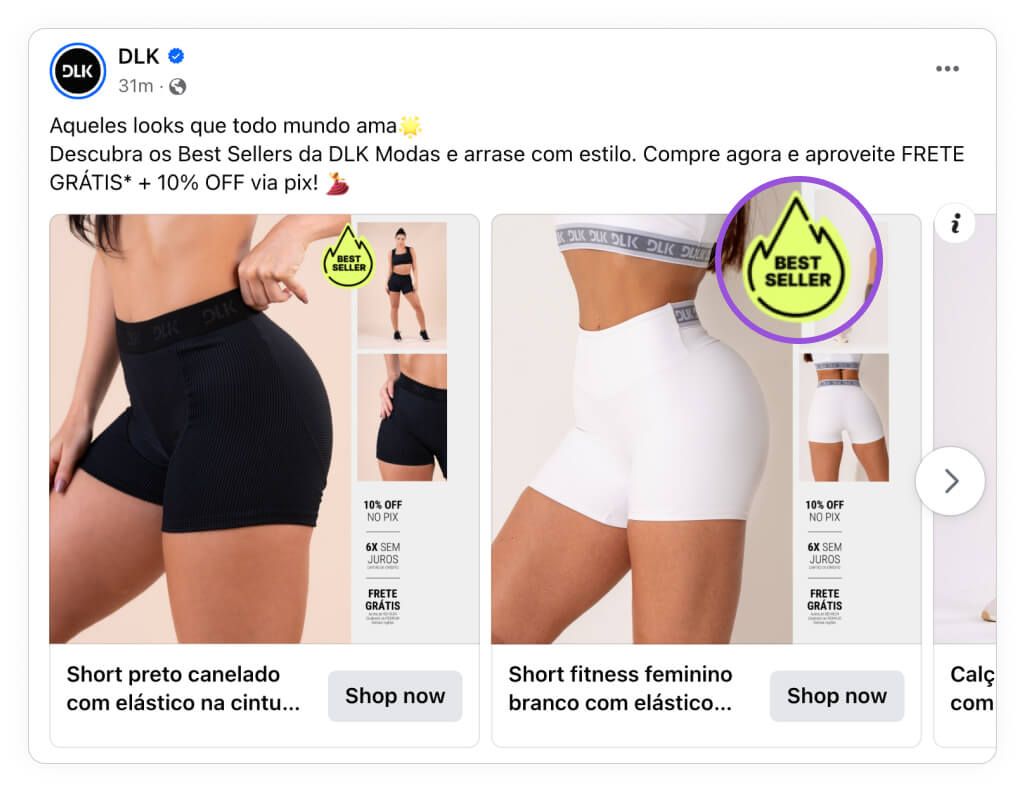
When showing social proof, you’re basically getting other people to hype your products for you.
And when you show social proof, whether it’s a positive review from a customer or a 5-star rating from a third-party site, you make your brand that much more trustworthy.
And that trust can mean all the difference in the world between finding your next customer and a bounce.
Here's how showing social proof on average influence Catalog Ads:
Return On Ad Spend
+22%
Cost Per Purchase
+22%
Click Through Rate
-25%
Cost Per Click
+39%
Conversion Rate
+25%
Usage
7%
These numbers show how Catalog Ads showing social proof perform on average compared to Catalog Ads not showing social proof.
Remember that these are average numbers. For some brands, social proof perform better, and for other brands, social proof perform worse.
Showing Product Brands in your Catalog Ads
Showing product brands can help potential customers get over any hesitation they may have about buying from you.
After all, they may not recognize your eCommerce brand. But they certainly know major DTC brands like Nike, Apple, HP, Bose or Sonos.
So when they see your store carrying these types of high-quality, branded products, they’re much more likely to take a second look.
Showing product brands can boost conversion rates by +189%
Showing product brands can lower cost per purchase by -13%
That’s a seriously nice boost to your conversion rate, right?!
But there are some other potentially negative side-effects to showing product brands, such as a lower ROAS and an increased average cost per click.
Here's how showing brand names on average influence Catalog Ads:
Return On Ad Spend
-53%
Cost Per Purchase
-13%
Click Through Rate
+5%
Cost Per Click
+39%
Conversion Rate
+189%
Usage
1%
These numbers show how Catalog Ads showing brand names perform on average compared to Catalog Ads not showing brand names.
Remember that these are average numbers. For some retailers, brand names perform better, and for other retailers, brand names perform worse.
Showing Custom_labels in your Catalog Ads
With Confect, you can add custom label overlays directly onto your catalog ad’s product images.
This can be a great way to show people specific information about your products to help reel them in.
For instance, you might include product specs or any other features or benefits that you think your ad viewers might find helpful.
Essentially, you want to show them important information about the products they’re looking at, without them having to click on the ad just to learn more.
So after reading the custom label, if they follow-through and click on your ad, they're better qualified and more likely to make a purchase from you.
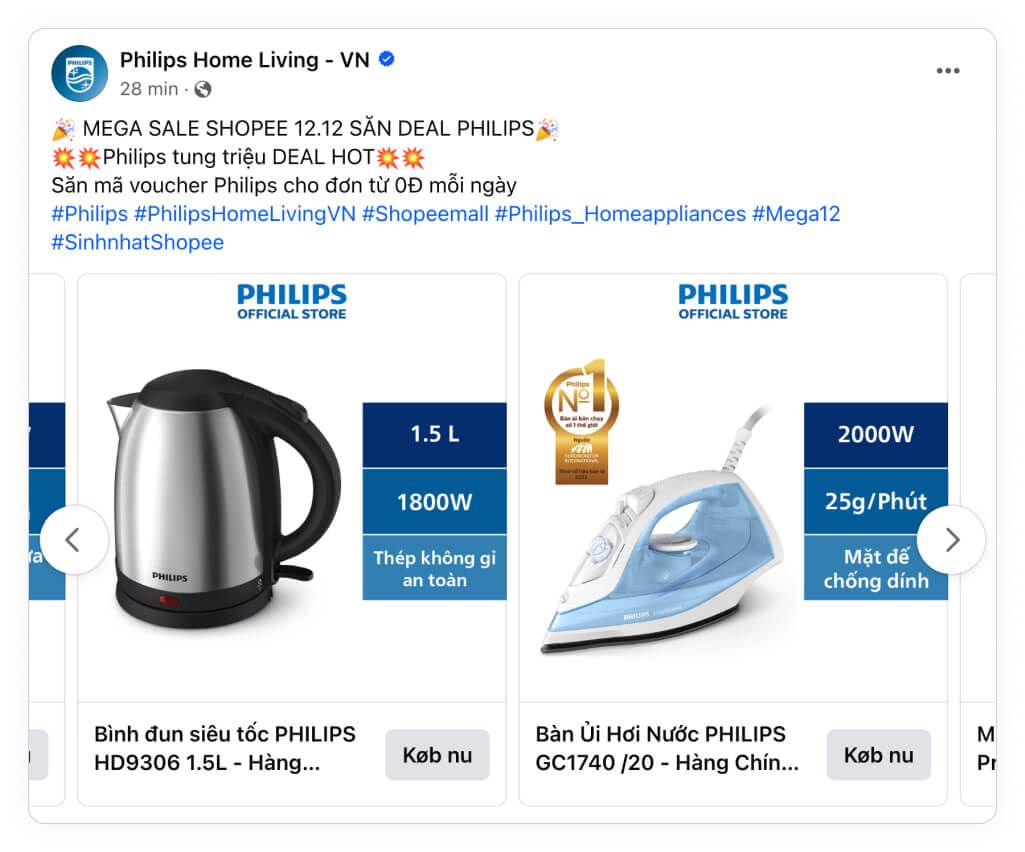
But just how do custom labels perform?
Unfortunately, the results aren’t actually all that great for brands that include custom labels on their catalog ads…
As you can see below, including custom labels resulted in a lower return on ad spend, a lower click-through rate, and a lower conversion…
It’s not really a pretty picture.
Here's how showing custom labels on average influence Catalog Ads:
Return On Ad Spend
-36%
Cost Per Purchase
-15%
Click Through Rate
-11%
Cost Per Click
-43%
Conversion Rate
-36%
Usage
7%
These numbers show how Catalog Ads showing custom labels perform on average compared to Catalog Ads not showing custom labels.
Remember that these are average numbers. For some brands, custom labels perform better, and for other brands, custom labels perform worse.
Showing Categories in your Catalog Ads
One other great way brands can choose to display catalog ads is based on their product categories.
This can be an extremely effective way to show your products because it shows the viewer a range of products that are similar in nature.
Maybe they’re just not interested in the first product they see on the ad.
If this was the only product they could see, they’d probably just keep scrolling through their feed, leaving your catalog ad behind in the dust.
But when there’s another similar product right next to that first product, there’s a much better chance they’ll swipe to it, and start browsing through other similar products.
Showing categories resulted in a +14% better Return on Ad Spend
Showing categories improved Click-Through Rate by +35%
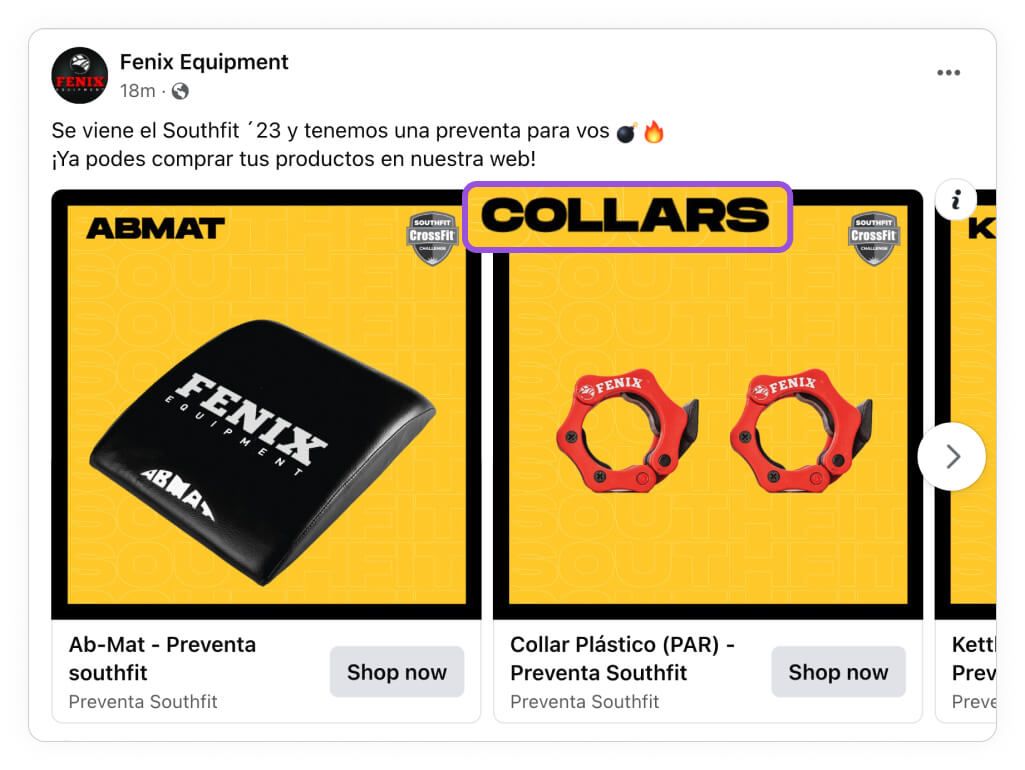
Here's how showing product categories on average influence Catalog Ads:
Return On Ad Spend
+14%
Cost Per Purchase
-30%
Click Through Rate
+34%
Cost Per Click
-39%
Conversion Rate
-31%
Usage
3%
These numbers show how Catalog Ads showing categories perform on average compared to Catalog Ads not showing categories.
Remember that these are average numbers. For some brands, categories perform better, and for other brands, categories perform worse.
Showing Product Descriptions in Catalog Ads
For any type of ad to be effective, it needs to provide the viewer with as much valuable information as possible.
So product descriptions really can be great to include in your catalog ads because it’ll tell the viewer basically EVERYTHING they need to know.
Essentially, the more an ad viewer knows about the product they’re looking at without having to click on it, the better.
Meaning the people who see and read your product description will be that much more likely to pull the trigger and make that next purchase.
But just how much can product descriptions improve your catalog ad performance?
Showing Product Descriptions can increase Return On Ad Spend by +57%
Showing Product Descriptions improves Click-through rate by +14%
Here's how showing descriptions on average influence Catalog Ads:
Return On Ad Spend
+57%
Cost Per Purchase
+36%
Click Through Rate
+14%
Cost Per Click
+2%
Conversion Rate
-66%
Usage
1%
These numbers show how Catalog Ads showing descriptions perform on average compared to Catalog Ads not showing descriptions.
Remember that these are average numbers. For some brands, descriptions perform better, and for other brands, descriptions perform worse.
How can brands create even more effective Catalog Ads?
As you can see, there’s a ton of different ways brands like yours can improve their catalog ad performance, from including simple information like price, savings and discounts to showing more detailed information like product assets, descriptions and custom labels.
With Confect, it’s easy to take the existing information you have about your products and turn it into custom image overlays that can make your catalog ads that much more effective.
Putting valuable information directly on your product images just makes your ads look that much more professional.
But even more importantly, it provides potential customers with the information they’ll need to decide whether or not they want to browse your products and buy something from you.
This ensures that the people who do click-through and land on your webstore will be better qualified.
And better qualified traffic means you’ll have a much better shot at making that next sale!
Still, the results we discussed today might vary from one brand to another, depending on their product offering and target audience.
Which is precisely why we always recommend brands experiment with different ad layouts, A/B tests as much as possible, and find out what really works for their products and their audience.
Bookmark this page by pressing ctrl + D / cmd + D, or by clicking the star icon in your URL bar ⭐️.
